The battery-electric models from BMW compete as the SUV iX against the Tesla Model X and as the Coupé i4 against the Tesla Model 3. The Grace of Later Birth.
The BMW iX corresponds to the format of the X5, but is battery-electric.
BMW is considered one of the electric car pioneers. The i3 impressed with its unusual shape and construction, but especially with its early market launch in 2013, when the mass-produced electric car market was only occupied by Nissan, Renault and Tesla.
Since then, little has happened at BMW in the field of electric cars, apart from the compact SUV iX3. But for a few months now, two new battery vehicles (BEV) from the manufacturer have been on the market, and two very different ones: here the iX, a massive SUV in the Tesla X segment, there the i4 as a coupé with similar dimensions to the Tesla Model 3 So it seems clear that BMW based its design of its new BEV primarily on the US electric pioneer Tesla.
The wait was worth it, because both new electric BMWs look much more mature than the Tesla models that were launched at least three years ago. It seems that the German manufacturer was able to benefit significantly from the experience of others, because the two vehicles have nothing in common with the i3, which is no longer produced.
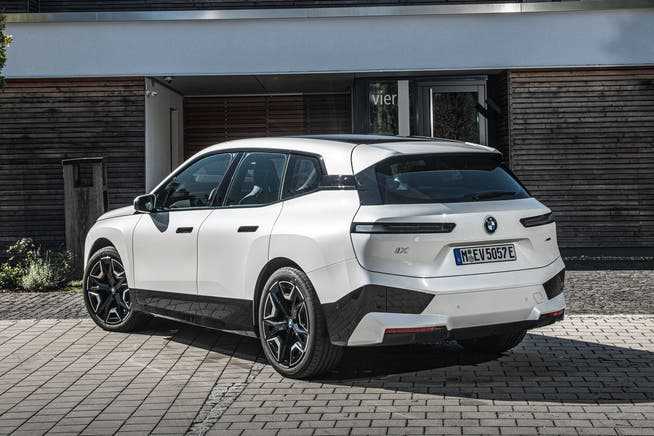
As dominant as the front grille may be, the rear lights are comparatively filigree.
The iX seems to be a bit out of the ordinary, at least in the field of electric cars. Although it is about the same length and width as an X5, it has the wheelbase of the next largest X7. This is made possible by the design of electric vehicles with all-wheel drive, which do not have to have a mechanical connection between the front and rear axles. Sophisticated electronics coordinate the four driven wheels. And the drive battery can be installed very flat in the underbody.
“When designing the BMW iX, the range was the most important criterion,” explains Johann Kistler, project manager for the electric SUV. “We wanted to build an electric car with no restrictions on mobility.” The goal seems to have been reached, because the weaker version iX xDrive40 has a range of 425 kilometers with one battery charge according to official measurements. The more powerful model iX xDrive50 results in 630 kilometers.
In order to achieve these values, it was essential to build a car that was as streamlined as possible. The drag coefficient cW is 0.25, a very good value for an SUV with a higher vehicle height.
With the iX, BMW speaks of intelligent lightweight construction, which seems a bit presumptuous with a curb weight of almost 2.6 tons. But apparently the iX would have been even heavier without the use of aluminum space frames from Rolls-Royce technology and carbon elements. Amazing: Despite the heavy drive battery, the car is 50 kilograms lighter than the conventionally powered BMW X5.
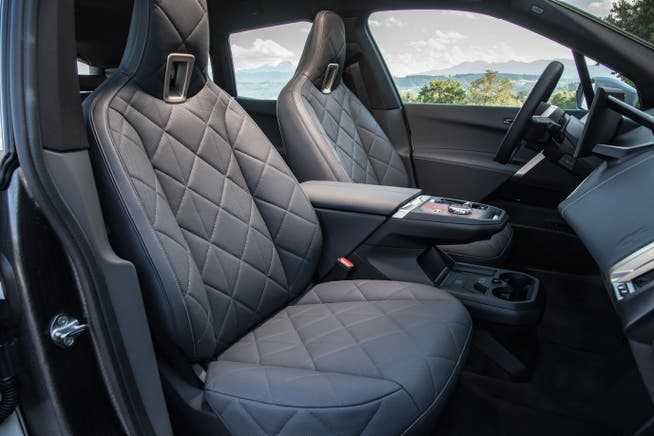
Beautiful armchairs, but little lateral support: the interior is unusual in every respect, but not just practical.
As far as the handling of the iX is concerned, Kistler promises the comfort of the 7-series sedan and the dynamics of the 5-series at the same time. First trips in the Bavarian mountains seem to confirm this full-bodied statement. What is striking is the enormous acceleration of the heavy car, seamless and linear on the German autobahn up to top speed. While this is typical of electric cars, it is surprising given the imposing appearance of the iX with its huge double kidney grille at the front and the large 20-inch wheels.
As far as environmental compatibility is concerned, the batteries and electric motors are exemplary. The batteries still contain cobalt, but the raw material is procured from certified mines in Australia and Morocco, as Andreas Janus from BMW powertrain development reveals. In addition, the electric motors are not provided with magnets, but are electrically excited. Rare earths are therefore no longer used here at BMW.
At high speeds, it is noticeable how well the car is insulated against noise from outside. Foam filled into the tires ensures low rolling noise, the interior is also sealed against wind noise, and the engine would not be audible if the film musician Hans Zimmer had not composed an enchanting electronic sound. The noise of driving on the motorway at 200 km/h already makes it feel like a country trip at 80 km/h – the iX can be moved in a correspondingly relaxed manner, to which the high directional stability, supported by the lane assistant, contributes.
Of course, long journeys at high speeds are at the expense of the range. On the first freeway test drives south of Munich, the range decreased by one kilometer every four seconds.
The iX shows its superior traction on winding sections. If the vehicle is normally only driven by the rear wheels, the front-wheel drive switches on within milliseconds if necessary – for example when exiting tight bends. When this happens, you don’t feel any jolts, the driving forces are dosed as finely and precisely as you would expect from a modern electric car with all-wheel drive.
However, the iX not only impresses with its imposing body and its remarkable electric drive, but also with its futuristic interior. Anyone who takes a seat in one of the wide armchairs will be impressed by the enormous sense of space. Many conventional parts, such as the dashboard, are shaped differently than we are used to, on the one hand more angular and prismatic, but on the other hand more suitable for everyday use. However, the same cannot be said of the seats, which, while comfortable when the car is stationary, lack lateral support at every turn.
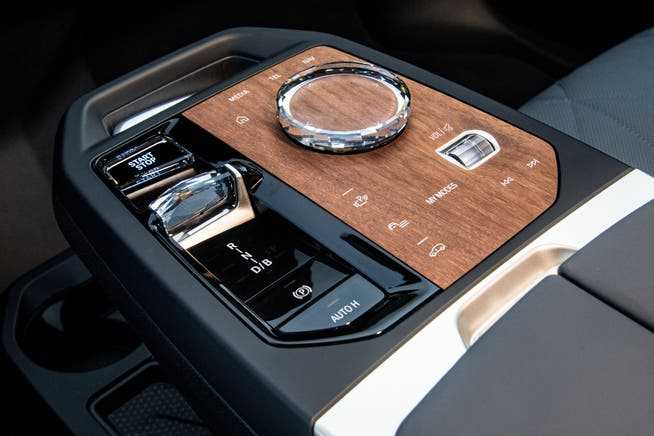
The control panels in the center console are integrated into the touch-sensitive wooden surface. Crystal glass dominates.
As a result, BMW has built a good alternative to the Tesla Model X with the iX, which also does not require exalted gullwing doors. Prices start at 98,700 francs for the iX xDrive40, but the iX xDrive50, which is a good 15,000 francs more expensive, has a significantly longer range of 630 kilometers. That is worth the steep surcharge for many electric car buyers these days.
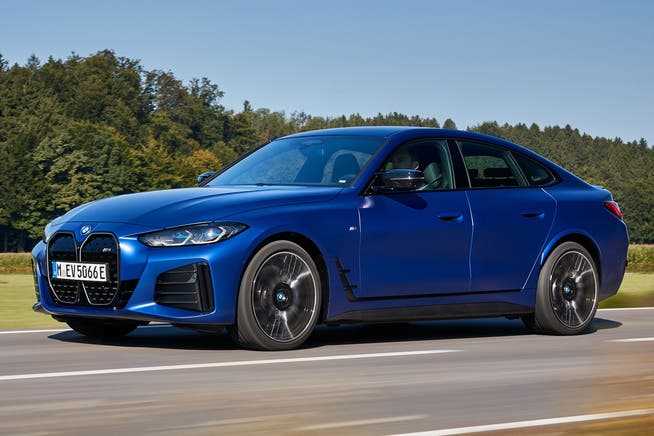
Visually, the i4 (the M50 in the picture) is the battery-electric variant and can hardly be distinguished from the 4 Series Gran Coupé.
The BMW i4 is significantly closer to the petrol-powered equivalent than the iX, which differs significantly from the X5. The development of the i4 is based on the 4 Series Gran Coupé, so the same BMW engineer, Daniel Mögele, is responsible for developing the drive train with the combustion engine and the battery-electric drive.
The look of the i4 largely corresponds to that of the four-door 4 Series Gran Coupé, which also applies to the interior. There are differences at the front, where the striking double kidney grille is closed compared to the petrol engine, because cooling air is not necessary in this area, it only interferes with the aerodynamics. The air flow has also been improved on the rims for the 19 and 20 inch wheels by inserting plastic elements into the standard spoked wheels.
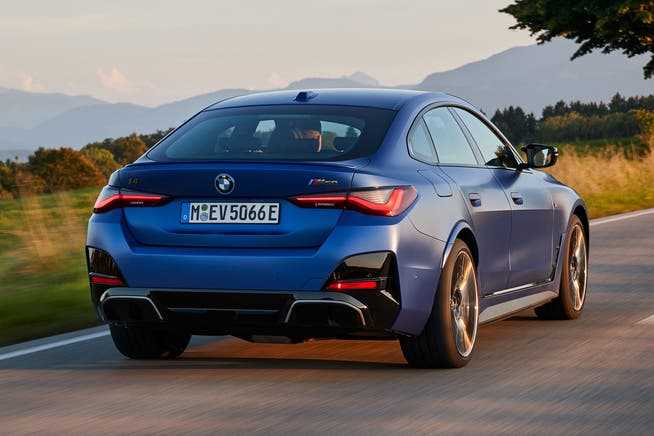
The tailpipes are missing in the rear – typical for an electric car.
When driving the i4, which is also equipped with an electric motor on each axle, Mögele speaks of a traction system close to the actuator, which, due to its small distance between the introduction of force and the wheel, should make the wheels react ten times faster to the accelerator pedal.
We drove the currently most powerful version of the i4, the M50 with 400 kW. In fact, the spontaneous acceleration is comparable to a Tesla Model 3 Dual Motor, but as soon as the car corners, the superiority of the BMW becomes apparent. Compression and damping work more harmoniously and a little softer than the Tesla, and the i4 M50 absorbs bumps a little better than its American competitor. Mögele knows one of the reasons: “With the i4 M50 we installed a particularly torsion-resistant chassis, which the other i4 don’t have.”
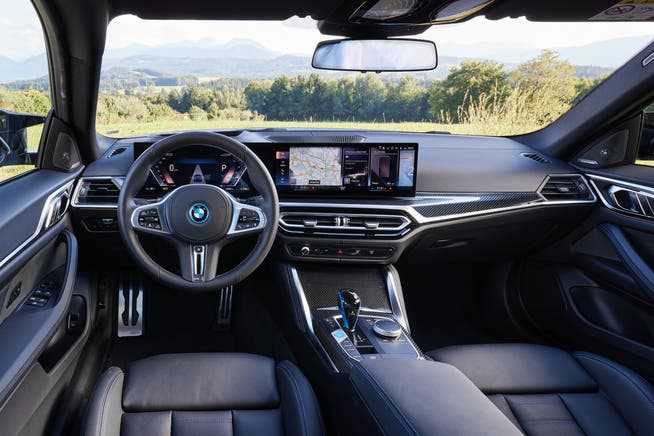
A panel consisting of two screens provides all information for the i4 driver.
It’s not just the acceleration of the electric four-door coupé that is addictive, the matching background noise when driving in sport mode is also a dream. Here Hans Zimmer has actually achieved great things when you compare the electronic sound with that of the competition. Not least because of the good ergonomics in the cockpit, you feel like you’re in a video game.
There’s no question that the i4 M50 is a superior, first-class piece of sports equipment even on the foothills of the Alps. With its precision and pleasant road feedback, the steering fits perfectly with the chassis, and thanks to the drive battery installed in the underbody, the low center of gravity ensures additional stability in corners.
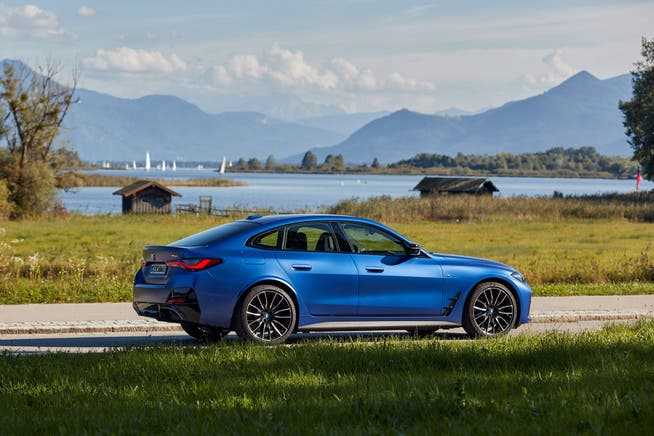
Interesting alternative to the Tesla Model 3: BMW i4.
With a range of more than 500 kilometers, the BMW i4 M50 is a good choice. In terms of price, the vehicle is at the upper end of the range when compared to the competition. Alternatively, there is currently the BMW i4 eDrive 40 with rear-wheel drive from 69,900 francs. In a quality comparison with the Tesla Model 3, however, the i4 is ahead, and the same applies to the iX compared to the Model X. Both vehicles were created later, the engineers observed well how other teething troubles went through. Thus, iX and i4 benefit from the grace of late birth.
